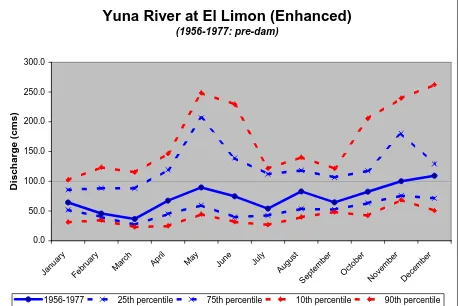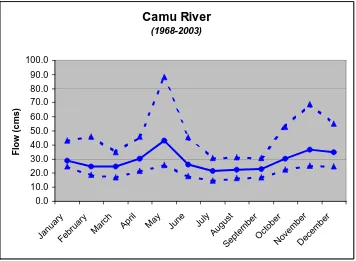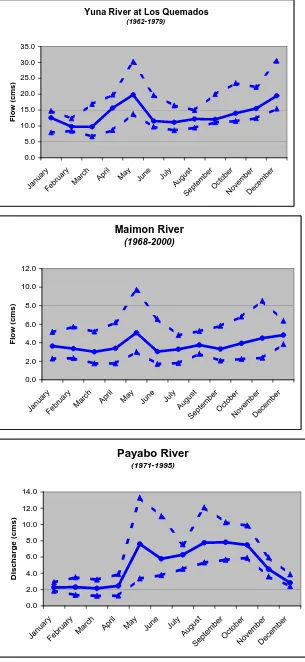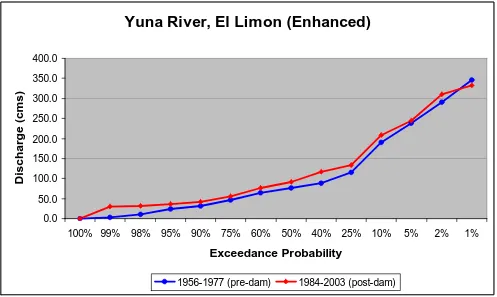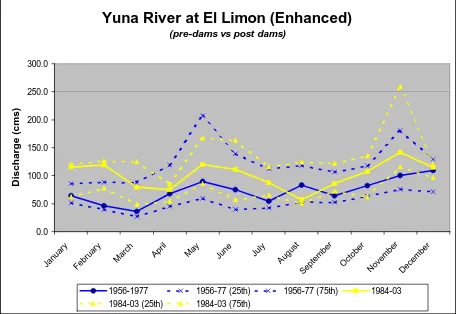MANAGING FRESHWATER INFLOWS TO ESTUARIES
Yuna River Hydrologic Characterization
A. Warner
Yuna River Hydrologic Characterization
This write-up summarizes a coarse hydrologic characterization of the Yuna River and tributaries and is to be combined with a water budget and ecological summary of the Yuna River watershed and associated Samana Bay system. These reports are being developed concurrently and will support the development of a more comprehensive site profile of the basin and bay. A description of the watershed – including its major tributaries and Samana Bay – is presented in the water budget document.
The purpose of this analysis is to provide a brief characterization of the natural patterns of river flows into Samana Bay and to assess whether or not those patterns have been substantially altered during the past four decades. This information combined with the ecological summary and the water budget will help identify relationships between river flows and important biological processes and habitat conditions, and help identify whether or not changes have occurred in ecologically important aspects of the river’s flow regime and the freshwater inputs to Samana Bay.
The hydrologic characterization is presented below, following a brief description of the data used in this assessment.
Analyzed Data
This characterization considered data from six stream gage stations in the Yuna River watershed (Table 1). Three of these stations are located on the Yuna River (near Los Quemados, Villa Riva, and El Limon), with the other three stations located on the Maimon, Camu, and Payabo tributaries of the Yuna. All available data from these stations were average monthly values. While the periods of record shown in Table 1 for each station represent the starting and ending years of data, there are gaps of varying length in all of the records.
tributary inflows (e.g., from Payaba) and likely groundwater inflow as well. The
correlation of flow between the two gages is high and used as justification for combining the data sets into a single flow record extending from 1956 through 2003, referred to as the “El Limon – Enhanced” data set. This data set consists of:
1. 1956-1968: average monthly flows at Villa Riva with 16 cms added to each value to account for additional flow at El Limon; and,
2. 1969-2003: average monthly flows at El Limon.
Where these data are used in this characterization, they are referred to as “El Limon – Enhanced”. Data sets from all other gage stations were not modified.
Hydrologic Characterization
The available data were analyzed in two basic ways. First, periods of record prior to the construction of Rincon and Hatillo dams (1978 and 1984, respectively; INDRI, 2001) were used to identify “natural” seasonal patterns of flow and flow variation. While there were human activities in the watershed – such as significant land cover conversion and irrigated agriculture – well prior to 1978 that may have influenced river flows, hydrologic modeling would be needed to reconstruct “natural” (unaltered by human activities) Yuna River flows. This type of modeling is beyond the scope of this project. Instead, the El Limon – Enhanced gage between 1956 and 1977 is considered relatively unimpacted and more reasonably characteristic of natural flow patterns. The more recent flow records from the gaged tributaries – which are uninfluenced by the dams – are also compared to patterns identified on the lower Yuna in the pre-dam period.
The second type of analysis presented here looks at comparisons between pre-dam (1956-1977) and post-dam (1984-2003) flows. This analysis is presented only for the El Limon – Enhanced record, as it is the only record with adequate pre- and post-dam data.
Characterization of “Natural” Flow Patterns
The general pattern of seasonal flows on the Yuna River has been noted to include a dry season that runs from December through March and a wetter period from April through November, with May-June and October-November as the most likely months for larger flows and flooding (OAS, 1969). The data from the Yuna River near El Limon
The Camu River – the Yuna’s largest tributary – exhibits the same “bimodal” seasonal pattern of wet periods as the Yuna (Figure 3), although flows during the dry January to March period are consistently higher than those experienced between July and
September. Similar seasonal flow patterns are also seen further up on the Yuna (Los Quemados gage) and on the small tributary of the Maimon (Figure 4). The Payabo River – a small tributary to the Yuna draining the border between the Sanchez Ramirez, Monte Plata, and Duarte provinces – has some slight differences in its seasonal flow patterns as compared to the other tributaries (Figure 4). It has an even more pronounced December to April dry period and flows between May and November tend to remain relatively and consistently high.
Assessment of Changes in the Yuna River Flow Regime
Across a period of record for a stream gage, natural variations in climatic conditions – especially the timing and amounts of rainfall in a region – have a substantial impact on a river’s flow regime. These differences can manifest as variations in the overall volume of water discharged by the river during the year, the size, time of year, and duration of floods or low flow conditions, and the frequency of these types of flow conditions within or across years. A number of human activities can change one or more of these natural characteristics of a river’s flow regime, including land use conversion, construction and operation of dams, and ground water pumping or direct surface water diversions. And while humans have been present and active in the Yuna watershed for many years, two dams were built in recent decades, and the remainder of this assessment focuses on their potential to have influenced the Yuna’s flow regime and consequently the freshwater inputs to Samana Bay. Summary information for these two dams (Rincon and Hatillo) is presented in Table 2 and their dates of beginning service are overlaid against the El Limon – Enhanced period of record in Figure 5.
References
Instituto Nacional De Recursos Hidrailicos (INDRI). Departmento De Planificacion, Programa Cultura Del Educativas. Material Basico Para Ponencias (Doc. PCA-05-01.1). Octubre 2001.
Organization of American States, Natural Resources Unit of the Department of Economic Affairs. Survey of the Natural Resources of the Domincan Republic: Study on the
Tables
Station Name (number) Quad Name Period of Record
Yuna, near Los Quemados (180001) Bonao 1962-1979 Yuna, near Villa Riva (180003) Villa Riva 1956-1992 Yuna, near El Limon (180004) Cevicos 1969-2003
Maimon River (184001) Bonao 1968-2000
Camu River (185003) Cotui 1968-2003
Payabo River (187002) Cevicos 1971-1995
Table 1: Gaging stations in the Yuna River watershed.
River Dam Name
Began Service
Height (meters)
Reservoir Elevation (m.s.n.m.)
Dam Type Reservoir Capacity (MMC)
Installed Power (MW)
Generation (GW-h/a)
Catchment Area (km2)
Irrigated Area (ha)
Yuna Hatillo 1984 50 86.5 Tierra (earth) 375.3 8 50 1167 22,000 Jima Rincon 1978 54 122 Gravedad (?) 60.1 10.1 30 159 7,565
Figures
Yuna River
(comparison of Villa Riva and El Limon data)
y = 0.8739x + 16.123 R2 = 0.8979
0 50 100 150 200 250 300 350 400 450
0 50 100 150 200 250 300 350 400 450
Villa Riva Gage (discharge, cms)
El Limon Ga
ge
(dis
c
h
a
rge
, c
m
s
)
Yuna River at El Limon (Enhanced)
1956-1977 25th percentile 75th percentile 10th percentile 90th percentile
Camu River
(1968-2003)
0.0 10.0 20.0 30.0 40.0 50.0 60.0 70.0 80.0 90.0 100.0
Janu
ary
Febr
uary
Ma
rch April May June July
Augus
t
Sep
temb
er
Octo
ber
Novemb
er
Dece
mbe
r
Flow (cms)
Yuna River at Los Quemados
Yuna River, near El Limon (Enhanced)
(1956-2003)0 50 100 150 200 250 300 350 400 450
Jan-56Jan-59Jan-62Jan-65Jan-68Jan-71Jan-74Jan-77Jan-80Jan-83Jan-86Jan-89Jan-92Jan-95Jan-98Jan-01
Discharge (cms)
Rincon Dam (1978)
Hatillo Dam (1984)
Yuna River, El Limon (Enhanced)
0.0 50.0 100.0 150.0 200.0 250.0 300.0 350.0 400.0
100% 99% 98% 95% 90% 75% 60% 50% 40% 25% 10% 5% 2% 1%
Exceedance Probability
Discharge (cms)
1956-1977 (pre-dam) 1984-2003 (post-dam)
Yuna River at El Limon (Enhanced)
(pre-dams vs post dams)
0.0
1956-1977 1956-77 (25th) 1956-77 (75th) 1984-03
1984-03 (25th) 1984-03 (75th)

